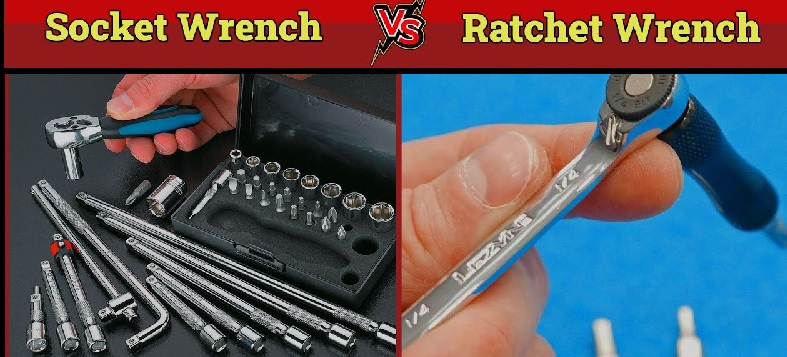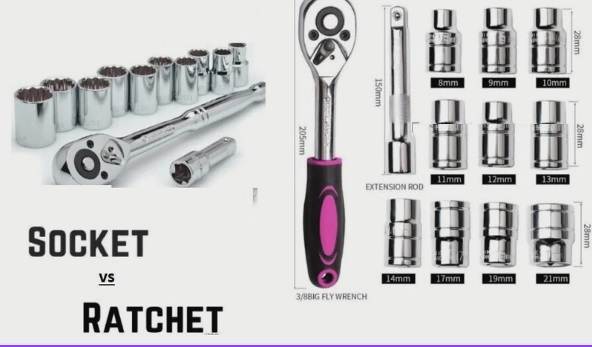High accuracy is needed for metalworking and woodworking, and the use of an accurate tool is important. Socket and ratchet wrenches are commonly used tools but come with different features and applications. Both tools are used for mechanical work and other functions. Here we will cover details of socket wrenches and ratchets and find their practical differences with uses.
What is a socket wrench?
- The socket wrench belongs to spanner types that operate with a closed socket as compared to an open wrench for fastener turning in the form of a nut or bolt.
- The common type used for ratcheting socket wrenches is also called a ratchet. The ratchet follows a reversible ratcheting mechanism that helps to pivot tools back and forth for turning sockets rather than removing and repositioning the wrench.
- For driving socket pneumatic impact wrenches, torque multipliers and hydraulic torque wrenches are used.
- Hybrid drivers come with striking wrench tools that have square drive and hydraulic impact wrenches.
What is a ratchet wrench?
- The ratchet wrench is a handheld tool that operates for loosening or tightening bolts and nuts. It comes with the handle having ratcheting process operations, but as compared to a socket wrench, it comes with a fixed square drive size and does not use interchangeable sockets.
- Ratchet wrenches come with certain sockets with different sizes built into the tools.
Where to use a ratchet wrench
- A ratchet wrench is good to use for applications that require a certain bolt and nut size. Since they come with fixed sockets, they are good to use for repetitive operations that need the same size of bolts and nuts.
- The accurate turning of ratchet wrenches for toggling between tightening and loosening.
Socket Wrench Working
- The socket wrench comes with a strong design. It is used for loosening and tightening fasteners with a handle and a socket. Through the use of leverage, you can easily solve tough problems.
- Some handles provide a knurled grip for providing easy control. It is best to use it for greasy conditions when working.
- Each socket comes with a certain structure that normally comes in hexagonal. It is used for fitting heads of standard nuts and bolts.
- Some other socket designs are Torx screws, spline drives, and fastener variations.
- For using a socket wrench, use a socket that is according to the design of the fasteners.
- The socket provides a connection for handling hinges on the locking system.
Size of the Socket Wrench
| Measurement System | Size Range | Use |
| Metric (mm) | 5mm | electronics or small projects |
| Metric (mm) | 10mm, 12mm, 13mm, 14mm, 15mm, 17mm | Automotive and mechanical working |
| Metric (mm) | 19mm, 21mm, 24mm and | Heavy machinery |
| SAE (inches) | 1/4″, 5/16″, 3/8″ | Precision work and light-duty |
| SAE (inches) | 1/2″, 9/16″, 5/8″, 3/4″ |
automotive repairs
|
| SAE (inches) | 7/8″, 1″, 1-1/16″ |
Heavy-duty applications
|
| Drive Size (inches) | 1/4 inch |
light-duty work
|
| Drive Size (inches) | 3/8 inch |
commonly used for general tasks
|
| Drive Size (inches) | 1/2 inch |
Heavy-duty work where high torque needed
|
| Drive Size (inches) | 3/4 inch and 1 inch |
Industrial-grade and heavy-duty applications
|
Shapes of Socket Wrenches
- There are different sizes and shapes of socket wrenches. Use a certain type that can fit on the fastener and avoid any damage.
Six-Point Sockets:
- It is a common size type for sockets. These sockets come with 6-sided walls. It can fit hexagonal nuts and bolt heads.
Twelve-Point Sockets
- This socket operated with hexagonal fasteners. They come with 12 contact points rather than 6.
Torx (Star) Sockets
- It is made for fasteners and has a star-like head. It is used for tamper-proof screws.
Impact Sockets:
- It is a heavy-duty socket that is made to use with impact wrenches.
Deep Sockets:
- It has a cavity as compared to standard sockets.
Pass-Through Sockets
- It has a hollow center that provides long threaded rods to pass through.
Features of Socket Wrench
Torque:
- The long handle of the socket is called a lever. It applies forces, resulting in torque.
Versatility:
- For interchangeable sockets, the single socket wrench effectively handles a wide range of fastener sizes and shapes.
Efficiency:
- The easy socket grip and proper turning of the handle help the socket wrench operate at high speed and in a more effective way than conventional wrenches.
Reachability:
- Deep sockets help us to easily reach nuts and bolts that come with long threaded rods. So good to use for tight spaces.
Precision:
- Snug fit reduces slipping fastener head. It provides high accuracy.
Leverage:
- Longer handles provide leverage that provides force expansion with low force.
Types of Ratchets
- The main types are flex head ratchet. Comes in different size such as 1/4in, 1/2 inch and 3/8 inch, for controlling different size sockets.
- Some operated with geared drive that with high tooth count helps to control tool having smaller swing motion that is good if there is small area for moving handle
- Gearless models work with roller bearing and needed small motion for turning fastener as compare to drive
- Jointed ratchets helps to set angle of handle for operating in tight locations.
Types of Sockets
Pass-Through Socket
- The pass-through socket and ratchet turn the nut on the longer, threaded bolt, helping the bolt to move through the socket and ratchet.
- It comes with a low-profile design that minimizes the use of low-profile and deep sockets.
- It operated with specially made ratchets.
Driver Socket
- It comes in standard socket sets and Phillips driver sockets and flathead driver sockets.
- The fasteners are flathead, Phillips, and star-head screws.
Spark Plug Socket
- Kobalt spark plug socket, comes with a deep design for fitting the structure of the spark plug.
- It is configured with rubber inserted for a grip plug, which helps to pull when loosened.
Impact Socket
- The shallow impact socket and deep impact are made to operate with pneumatic wrenches.
- It is made with such materials that control impact action without damaging.
- It comes in low-profile and deep designs and has a thick wall as compared to a standard socket.
Sizes of Ratchet Wrenches
| Drive Size (inches) | Use | Socket Size Range | Socket Size Range |
Torque Rating
|
| 1/4 | electronics, small projects | 4mm – 13mm | 3/16″ – 1/2″ | Low |
| 3/8 | Used for general tasks furniture assembly, automotive repairs | 7mm – 19mm | 1/4″ – 3/4″ | Medium |
| 1/2 | Heavy-duty work requiring more torque | 10mm – 24mm | 3/8″ – 1″ | High |
| 3/4 inch and 1 inch | Industrial-grade and heavy duty that needed very high torque | 22mm and up | 7/8″ and up | Very High |
Differences Between Socket and Ratchet Wrenches
Socket Wrenches
- Conventional socket wrenches are removed and rest after a single turn for locations where there is not much space for rotation.
Torque:
- This feature of this module helps to apply torque at a high rate due to leverage produced with longer handles.
Fixed Drive:
- It is a square design drive connection that fixes and sockets move about fasteners when the handle is twisted.
Socket Depth Options:
- Socket wrenches come with deep and shallow depths. Deep sockets are used for bolts having longer threads, and shallow used for average applications.
Ratchet Wrenches
Ratchet Mechanism:
- This process comes with a gear and pawl configuration where the fastener turned in a single direction and remained configured. Handle move in free reverse direction without affecting socket position on fastener that makes control continuous movement, and again fasten wrench for operating in confined areas.
Directional Lever:
- In some ratchets there is a small lever that controls the turning movement of the socket.
Efficiency:
- Standard wrenches need lift between turns, and so they are good to use for confined spaces.
Head Shape:
- Ratchets come in teardrop head shapes with some changes in clearance design that are good for certain working conditions.
Quick-Release Button:
- Ratchets have features for fast variation of sockets.
Tooth Count:
- It is based on ratchet-type teeth that can differ, with fine-toothed types providing small swing arcs that are good for tight spaces.
| Features | Socket Wrenches |
Ratchet Wrenches
|
| Ratcheting | Limited | High |
| Sockets | High – | High |
| Attachments | Moderate | High |
| Direction | repositioning for tightening/loosening |
Easy switching between tightening/loosening
|
| Space | Best to use for accessible fasteners, full rotation required |
Best to use for tight spaces, confined areas,
|
| Extensions | Limited |
Extensions provide reach for deep-set fasteners
|
FAQ
Is a socket wrench similar to a ratchet?
- Socket wrenches and ratchets are different since they have different operation mechanisms.
Can we use a ratchet instead of a wrench?
- Ratchets are good to use for confined spaces where a full turn is difficult with the use of a standard spanner. The ratchet system helps to provide effective work without connection and disconnection tools.
Define socket wrench and how to use it with a ratchet.
- The socket wrench is used for providing torque or turning force on fasteners like nuts or bolts through the socket. The socket fits over the head of fasteners and the handle of the wrench used for turning.
How is a socket connected with a ratchet?
- The socket is pressed; don’t drive the tang of the ratchet. The square-shaped socket drive interlocks with the square that is matching on the other. The spring system comes with detent balls in the ratchet head for a strong connection.
Is a socket wrench like a normal wrench?
- No, a socket wrench is a certain type of wrench. It comes with design interchange with the socket. The standard wrench comes with a fixed head size.
Which wrench is similar to a socket?
- • An adjustable wrench is like a socket wrench that can be set to fit different sizes of fasteners. Socket wrenches employ interchangeable sockets for accurate fit and adjustable wrenches based on one head that does not hold the fastener properly.
How to loosen a socket wrench ?
- Turning the handle of the socket wrench in an anticlockwise direction helps to loosen it.
How to loosen a tight socket?
- Follow these points.
- Apply leverage.
- Penetrating oil
- Tap it slowly.
Can we use pliers instead of a socket wrench?
- Pliers are another method for socket wrenches but not a good option. The fastener head can be damaged with pliers if not used in the proper way and sometimes does not have a strong grip for providing the required torque.
What is the replacement if I don’t have a socket wrench?
- You can use an adjustable wrench when you don’t have a socket wrench. But be careful since it does not fit accurately and can damage the fastener head. Good is that you use the right tool, like a socket wrench, for the required results.

